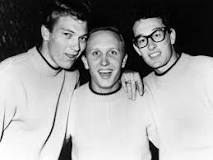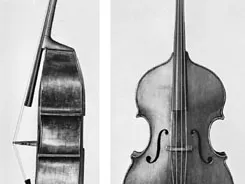AN UPRIGHT CITIZEN OF THE ORCHESTRA
AN UPRIGHT CITIZEN OF THE ORCHESTRA
Norman Warwick meets The Double Bass
Don´t mis-read our headline,….it is the double bass that is an upright citizen of the orchestra, not Norman Warwick. The double bass stands distinguished in any orchestra, although in jazz it is perhaps rather more adventurous and exploratory, and in folk bands it is often quite predominant, and in rock and roll, since at least as far back as Buddy Holly´s day the instrument has been slapped, spun around and even laid out on its back whilst its maestro (in the case of the crickets that was Joe B Mauldin) would sometimes lie down beside to pick the strings.

Quiet, good-natured and unassuming, Joe B Mauldin (left) was nobody’s idea of a rock star, but he played stand-up bass for Buddy Holly and after the singer’s death in 1959, continued as part of the Crickets. Mauldin was born in Lubbock, Texas in July 1940; his parents divorced when he was four years old
The Double Bass also is known as: Kontrabass, bass, bass fiddle, bass viol, bull fiddle, contrabass, contrebass, contrebasse, kontrebass, and string bass according to an entry in Encyclopaedia Britannica. This article was most recently revised and updated by Adam Augustyn

The Double Bass, (right), as a stringed musical instrument, is the lowest-pitched member of the violin family, sounding an octave lower than the cello. It has two basic designs—one shaped like a viol (or viola da gamba) and the other like a violin—but there are other designs, such as that of a guitar.
It varies considerably in size, the largest normally being under 6 feet (1.8 metres) in total length. The body itself, without the neck, may be up to 4.5 feet (1.4 metres) for a full-size instrument, about 3.8 feet (1.2 metres) for a three-quarter size, and only slightly larger than a cello for the small chamber bass, or bassetto. A double bass is usually strung with four heavy strings pitched E1–A1–D–G; a fifth string is occasionally added, in jazz band basses, at the top of the register to allow high notes to be played more easily; in symphony orchestra basses, below the E string, tuned to C. Many basses, rather than having a fifth string, have a mechanical device with levers that increases the length of the fourth string. With this device the pitch of the E string may be lowered to E♭, D, D♭, or C, or clamped to sound E when the lower notes are not needed.
Two styles of bass bow are currently used: the short and narrow French bow (like a violin bow), held palm downward, and the broader German bow (like a viol bow), held palm upward. The double bass also can be played pizzicato (by plucking with the fingers)—occasionally in symphonic orchestras and almost always in jazz and dance bands.
Forms of the double bass date from the late 15th or early 16th century and were in common use by the 18th century. Ludwig van Beethoven and later composers gave the bass increased importance in the symphony orchestra. Beethoven’s friend Domenico Dragonetti and the conductor Serge Koussevitzky, both skilled bassists, composed concerti for the instrument.
In jazz ensembles the bass forms part of the rhythm section and is also used as a melody instrument. It is often electronically amplified when played with such groups; an electric upright bass—a slender instrument that is easier to transport—is also common. In most rock and some jazz bands, the place of the double bass is taken by the electric bass guitar.
I cannot comment on any of the above as I have never performed in a band with a double bass and nor have I employed one in the recording studios, but I have always been thrilled by the work of players like Joe B Mauldin, and now, in a slightly different way I will always be thrilled by a new name to me, with the sense of fun whilst still retaining a reverence for the music and his instrument, as held by Mauldin.. So tomorrow Sidetracks and Detours will introduce readers to a great double bass player who has recently joined with an excellent exponent on the timple, and a world class guitarist, both well´loved around the Spanish peninsular and its islands, to record a wonderful new album. Check out tomorrow to find his identity here at Sidetracks And Detours.




Leave a Reply
Want to join the discussion?Feel free to contribute!